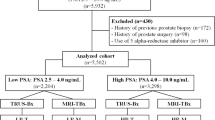Abstract
Transrectal ultrasound (TRUS)-guided needle biopsy of the prostate is a widely practised method for obtaining high quality tissue cores for histological diagnosis in men with suspected prostate cancer. Technological advances such as high-resolution hand held probes with biplanar imaging capabilities and spring-loaded needles that easily permit multiple biopsies to be obtained have ensured that this technique has rightly taken its place at the forefront of prostate cancer diagnosis. However, the capacity for TRUS to identify prostate cancer remains limited because of poor specificity and variability in the ultrasonic appearance of tumours. Widespread prostate-specific antigen (PSA) testing has increasingly resulted in greater numbers of tumours being diagnosed at an early stage, when they are clinically impalpable and ultrasonically indistinguishable from surrounding normal prostate tissue. In this setting, the principal role for TRUS is to facilitate systematic sampling of all relevant zones of the prostate. Despite advances in technology and in our understanding of this disease, a number of diagnostic dilemmas arise. Should we perform lesion-directed or random biopsies? How many tissue cores should be obtained for optimal diagnostic yield, to reduce the incidence of false-negative biopsies? What areas of the prostate should be biopsied to give the best diagnostic results? If the initial biopsies fail to detect cancer, who should undergo repeat biopsy? Some have also voiced concern that TRUS risks identifying clinically insignificant disease. Here, we review the studies that have addressed these issues and have lead to the evolution of TRUS-guided prostate biopsy into an essential tool in the detection of carcinoma of the prostate.
This is a preview of subscription content, access via your institution
Access options
Subscribe to this journal
Receive 4 print issues and online access
$259.00 per year
only $64.75 per issue
Buy this article
- Purchase on Springer Link
- Instant access to full article PDF
Prices may be subject to local taxes which are calculated during checkout
Similar content being viewed by others
Author information
Authors and Affiliations
Rights and permissions
About this article
Cite this article
Durkan, G., Greene, D. Diagnostic dilemmas in detection of prostate cancer in patients undergoing transrectal ultrasound-guided needle biopsy of the prostate. Prostate Cancer Prostatic Dis 3, 13–20 (2000). https://doi.org/10.1038/sj.pcan.4500398
Received:
Revised:
Accepted:
Published:
Issue Date:
DOI: https://doi.org/10.1038/sj.pcan.4500398
Keywords
This article is cited by
-
Recent advances in image-guided targeted prostate biopsy
Abdominal Imaging (2015)
-
Diagnostic Yield of Touch Imprint Cytology of Prostate Core Needle Biopsies
Pathology & Oncology Research (2009)



